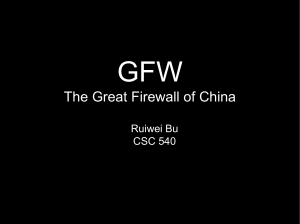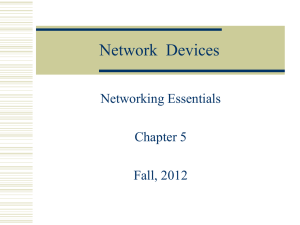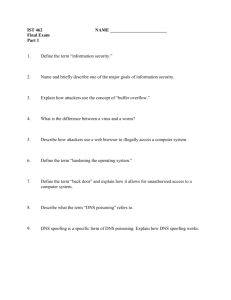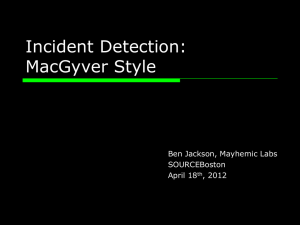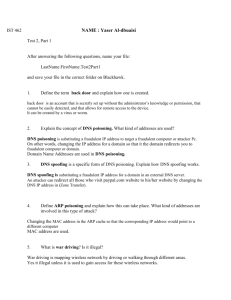Modifying DNS For Attack Redirection
advertisement
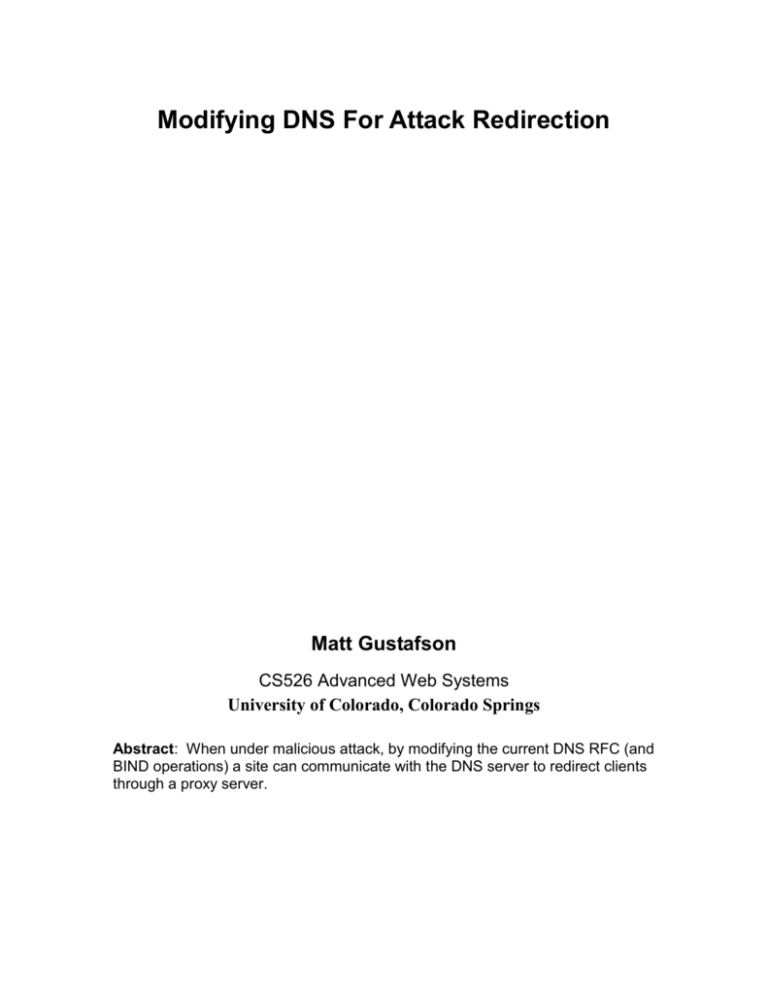
Modifying DNS For Attack Redirection Matt Gustafson CS526 Advanced Web Systems University of Colorado, Colorado Springs Abstract: When under malicious attack, by modifying the current DNS RFC (and BIND operations) a site can communicate with the DNS server to redirect clients through a proxy server. Table of Contents Table of Contents.................................................................................... 2 Introduction to DNS................................. Error! Bookmark not defined. The Problem ........................................... Error! Bookmark not defined. The DNS Request Process ..................................................................... 3 Requirements for a New DNS ................................................................. 5 Conclusion .............................................. Error! Bookmark not defined. Reference ............................................... Error! Bookmark not defined. 2 Introduction to DNS DNS or Domain Name Servers link the Internet Domain Name (i.e. www.sony.com, etc) to the real IP (Internet Protocol) address (198.124.0.2, etc). When the client requests a website, a request goes out to the DNS to locate the IP address. The DNS must find the right IP address for that website before any other data is communicated. The Problem Suppose that your gateway is under attack. Under the current DNS protocol, your customers are directed to that same IP address. This is a problem because they cannot access your website, due to the attack. But, let us suppose that if under attack, we could communicate this to the DNS server, which would then redirect all requests to a proxy server. What is required to do this? The DNS request process Currently, DNS is designed to return the current IP address or other information stored in a resource record. Your computer makes a request to the name server (which is running BIND), which in turn makes requests to that domain space. Let’s elaborate. On the client side the resolver is just a set of library routines and functions that are linked into the common programs, telnet and ftp. All the resolver does is put together a query, send it, wait for an answer and resend the query if it 3 remains unanswered (Albitz & Liu, 26). As web service and internet traffic has increased, resolvers have grown more complicated. More modern resolvers have a cache of frequently requested sites, in case the browser is purged of this information. Keep in mind all connection utilites use the resolver: ftp, telnet, POP3 mail, etc, not just your web browser. In this way the name server can keep current data on all servers in that domain. It must be remembered that it is critical for the name server to have this data. In reality there is a layering hierarchy from a zone server to the name server. Since DNS delineates names on several levels (from least specific to most specific). We will be dealing with a change on the client/server level, it is not as important that we address the communication between the name servers to the zone servers and so on. The resolver uses UDP to encapsulate the DNS query. This file structure is constant as shown below: 4 +--------------------+ | Header | +--------------------+ | Question | +--------------------+ | Answer | +--------------------+ | Authority | +--------------------+ | Additional | +--------------------+ The answer field contains the resource record (RR) with the answer. Authority contains the RRs pointing to an authority, and the Additional filed contains RRs that hold additional information. Now, some of these fields will be blank, depending on the query. Obviously, the client does not have the answer, immediately. But, this is the format used for queries. The resolver typically includes some specific information in addition to the name: type, source ,etc. This is usually sent and returned in a resource record. For queries, this is under the “Question” section, and for responses, “Answers.” Resource records exist in the name server in the following format: 1 1 1 1 1 1 0 1 2 3 4 5 6 7 8 9 0 1 2 3 4 5 +--+--+--+--+--+--+--+--+--+--+--+--+--+--+--+--+ | | | | | NAME | | | +--+--+--+--+--+--+--+--+--+--+--+--+--+--+--+--+ | TYPE | +--+--+--+--+--+--+--+--+--+--+--+--+--+--+--+--+ | CLASS | +--+--+--+--+--+--+--+--+--+--+--+--+--+--+--+--+ | TTL | | | +--+--+--+--+--+--+--+--+--+--+--+--+--+--+--+--+ | RDLENGTH | +--+--+--+--+--+--+--+--+--+--+--+--+--+--+--+--| | RDATA | | | +--+--+--+--+--+--+--+--+--+--+--+--+--+--+--+--+ Where, NAME: an owner name, i.e., the name of the node to which this resource record pertains. TYPE: two octets containing one of the RR TYPE codes. CLASS: two octets containing one of the RR CLASS codes. 5 TTL: a 32 bit signed integer that specifies the time interval that the resource record may be cached before the source of the information should again be consulted. Zero values are interpreted to mean that the RR can only be used for the transaction in progress, and should not be cached. For example, SOA records are always distributed with a zero TTL to prohibit caching. Zero values can also be used for extremely volatile data. RDLENGTH: an unsigned 16 bit integer that specifies the length in octets of the RDATA field. RDATA: a variable length string of octets that describes the resource. The format of this information varies according to the TYPE and CLASS of the resource record. (Mockapetris , Pg 10-11) So, your name server has to keep a list of the domain names as well as the IP address associated with that domain name. This is stored in an RR. But, there may exist several resource records for one name. BIND sorts through this and matches the information sought. Most commonly, queries request type A (host address), and the class title IN (internet). The name server keeps a TTL (time to live) that indicates how long clients will cache that entry. In this way, when it has expired, the client has to query the server again for that information. To keep the name server from being overwhelmed with queries, this is typically set long. Similarly, something has to keep the data in the DNS server current. What keeps this information updated with the current implementation of BIND and DNS? The most common answer, sadly, is whoever is maintaining the DNS. This is done manually. Because of this and the incredibly long TTLs on many files, it is not impossible to find a internet domain name that no longer has an IP address or that is referencing an old IP address, and it is this that is the crux of our problem. But, BIND 9 does support several secure protocol formats: DNSSEC, TKEY, SIG(0), etc. These are not designed for client/server interactions, but server/server interactions. To use these protocols both parties must have: a key, and the same algorithm for decoding the data using the key. They all operate in different ways BIND 9 uses another protocol to allow other server/clients to update RR information: Dynamic Update. But, the primary concern with dynamic update is that even using a key, UDP data can be easily cloned and forged. Since UDP itself is not secure and requiring all resolvers to support a secure format would also allow the client to still clone data, it is not used much, if at all. 6 But, both BIND 8 and 9, do use NOTIFY as a “heartbeat” mechanism. By using NOTIFY, one server can tell another to check its RRs for a certain address to see if it is current. If it no longer possesses current information, it will requery the source it obtained the data from. Requirements for a new DNS If our main IP address (presumably a gateway or server) is under attack, we want to update the RR in the DNS to reflect the IP for our proxy server or somehow communicate the IP of the proxy for all queries. Then when clients make a query to the name server, they would receive the IP for the proxy server. But, there are some implicit problems with this setup. Currently, the client does not query the name server if the TTL has not expired. This makes us question the TTL system. TTL is only respected by the server and not as a security issue, but rather as a failsafe to make sure all record information is current. Is there a way to replace this? We could make TTLs extremely short, so that the client would have to query the name server more frequently. But even if we assume that all resolvers would requery their local name server after a TTL expired, dynamic queries to the name server would increase traffic. This would cause considerable lag in internet communication. A better solution, would be to keep the TTL system in place, but if the client did not receive a timely response from the primary IP, the client would then query the name server, despite what value the TTL has. If the name server has not been informed of the IP of the proxy server, than the client would keep using the IP. This puts the onus of informing the name server of the attack onto the system that is under attack. Sadly, this method still depends on the resolver. At any rate, the resolver must be changed to reflect this properly, since it is not feasible to have the resolver dynamically update its data. It is also important to inform the client that they are using a proxy server. Ideally, several domain names may use one proxy server, so this could be much slower than our primary server. Under current DNS usage, the client will request type ‘A’ for host address, but should be able to take a new type of RR, we will call ‘PROXY’ as well as a port number and the IP address. But solutions and problems for the resolver should be a reflection of changes to the DNS protocol, not the other way around. Our solution lies more in communication from the name server than from the client (to the name server). In other words: what we are concerned with is how the name server knows a site is under attack and what information is encapsulated in responses to queries. Let us say that a site is under attack. The main server is bogged down in enough traffic that no data can be sent out. Through the proxy server, the system sends a message to the DNS, perhaps using a similar format to NOTIFY. Let us say that this is a message from the resolver, encapsulated in a UDP datagram, simply stating, ALERT and indicating the MAC address of the site under attack and the domain name. BIND would then have to set a field in the RR for that domain name, we could call ‘STATUS’. It would change all of the 7 STATUS values in all of the RRs to indicate that all queries should be answered with the information form the PROXY RR for that name. Now, we suggest using the MAC address of a server, since it is unique (a MAC address is like a serial number), but note that this “alert” would not indicate the IP for the proxy at all. We would assume that this information is already entered in an RR for the hosting name server. After the hosting name server is informed of the alert, it is then responsible for using the NOTIFY command to alert all other name servers, which in turn would do the like. This way all queries to that domain name requesting type ‘A’ would be returned with a type ‘PROXY’. The resolver may or may not need this information, but in case it does, it will know that it has the IP of a PROXY server (as mentioned earlier). It is possible then, for resolvers to be written that would constantly seek new information for all IPs associated with the PROXY type. But again, this is addressed earlier. If we simply sent the DNS the IP of our proxy server to replace the IP that already exists in our RRs, security in this transmission becomes an issue, otherwise, anyone could forcibly add a proxy server IP to the DNS. This is equally troublesome. Imagine an attacker that clones your website (copies all content to an alternate server), then attacks your main site. After you send the DNS the IP to your proxy server, the attacker sends a new IP to the DNS that references his clone site. He could then do anything from setting up a fake transaction script to steal credit card numbers to manipulating the data you present on your site. This is a very sobering thought. The only solution to this is to require that if a site will specify a proxy server, then this must be done when all RRs for that site are entered in the DNS. That means that this can only be done manually. This is the easiest way to do this. So now when the system is under attack, the site would merely send an RR that would indicate that it is under attack. Then the DNS would have to refer to the RR that references the IP address for the proxy server. But using NOTIFY is not ideal for other reasons. Why? Because we are transmitting data that should be hidden from the user. In other words, if we send the MAC address and the IP address and that method is supposed to make the data secure, we make the same mistake one makes with the idea that Dynamic Update/UDP datagrams are secure. While it may be nigh impossible to modify this since this is data sent for authentication only, it is still possible to capture and retransmit at any later time. A better idea, would be to use some type of “heartbeat” algorithm. By this, we could add an additional field called TTR (time to response). The name server would pulse the host address at a regular interval (this could be another field, TTP for time to pulse), if it did not receive a return pulse within the TTR, it would then automatically default all responses as PROXY. The pulse itself can be much simpler than a UDP datagram, since we aren’t giving out any information at all. Because it is much smaller, traffic will increase, but nowhere near as great as would have been the case using a constant dynamic update system, which is too insecure to be useful. The heartbeat system still has flaws. Because the data is not updated constantly, it is still possible for clients to be directed to the original IP of the host. 8 But, that said, we could possibly write DNS to support both facets of protection that we have proposed. The heartbeat system being the default, and the NOTIFY only being applied in certain cases (i.e. mission critical, etc). Although one hesitates to allow both, since chances are that everyone would choose NOTIFY and clog the datapaths anyway. Keep in mind that PROXY is not critical to this concept, this could easily be setup for just an alternate gateway with little change. Our concern lies more in routing through the PROXY server. Conclusion Yet this system is not without its flaws. A particularly malicious attacker could query the name server and obtain the IP address of the proxy server. If this were to happen, then an attack on the proxy server could commence and the site may simply be unaccesable. This is certainly a possibility. We could write DNS to act as a cop and not respond to queries from attacking IPs, but hackers don’t usually attack from a single IP. They may rout through multiple sources. Even so, this would be a poor, tedious solution, and would only complicate DNS more. Rather, DNS redirection is merely a tool to prevent a website from going down. Much like a lock on a door, there are ways around it to anyone who is resourceful enough. The plain truth is that this would not be foolproof by any means. Eventually, hackers would find a way around this. But, this is a simple solution that would be much easier to implement than trying to establish some public key resolver access methodology. It is relatively simple to make the changes in the DNS RFC and, subsequently, the code for BIND. But, it is another matter altogether to get the whole of the industry to adopt a new standard like this. It would require changes to web browsers, DNS servers, and network setup. The current DNS system has changed little in almost fifteen years. Reference Albitz, Paul & Liu, Cricket. DNS and BIND. Sebastopol, CA: O’Reilly, 1998. Mockapetris, P. RFC 1035 DOMAIN NAMES - IMPLEMENTATION AND SPECIFICATION. [updated Novemember 1987; cited 29 November 2002]. Available from ftp://ftp.isi.edu/in-notes/rfc1035.txt 9

